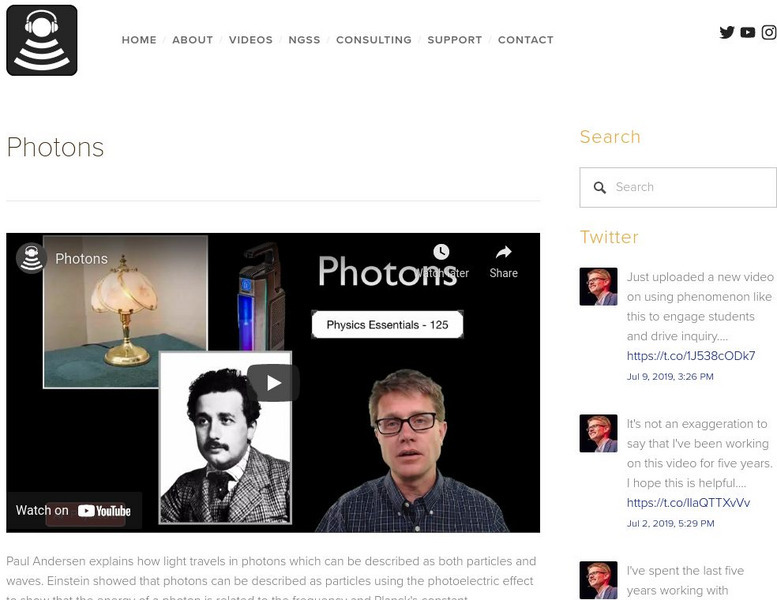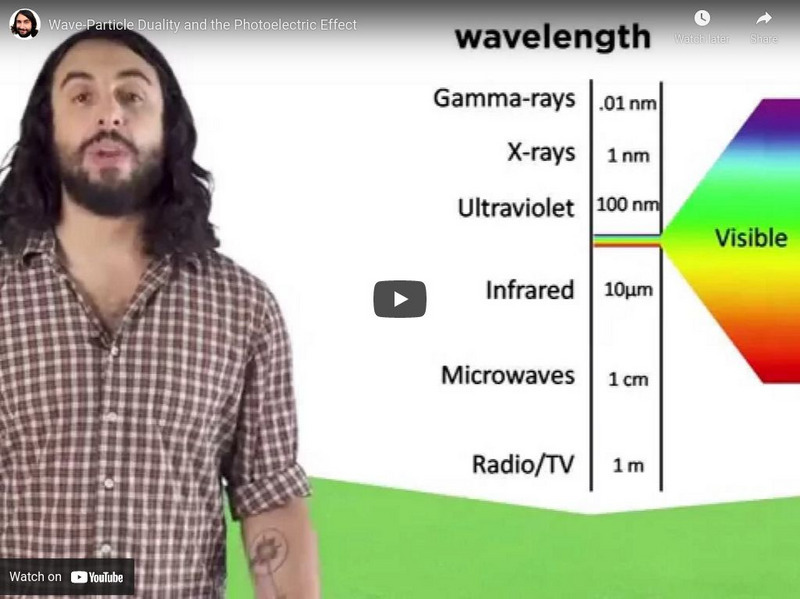TED Talks
Tim Harford: A powerful way to unleash your natural creativity
What can we learn from the world's most enduringly creative people? They "slow-motion multitask," actively juggling multiple projects and moving between topics as the mood strikes -- without feeling hurried. Author Tim Harford shares how...
Bozeman Science
Wave-Particle Duality - Part 2
In this video Paul Andersen explains how classical waves (like light) can have particle properties. Albert Einsetein used the photoelectric effect to show how photons have particle properties.
Bozeman Science
Photons
In this video Paul Andersen explains how light travels in photons which can be described as both particles and waves. Einstein showed that photons can be described as particles using the photoelectric effect to show that the energy of a...
SciShow
Solar Energy
Hank explains the power of solar energy and describes how it may fit into our diversified energy future.
Bozeman Science
Coulomb's Law
In this video Paul Andersen explains how we can use Coulomb's law to predict the structure of atoms. These predictions can be verified through the use of Photoelectron Spectroscopy (PES). Electron's are help around the nucleus because of...
Bozeman Science
Wave-Particle Duality of Light
In this video Paul Andersen explains how light can be treated as both a particle and a wave. Physicists use scale to determine which model to use when studying light. When the wavelength of light is equivalent to the size of the object...
Crash Course
Einstein's Revolution: Crash Course History of Science
There was physics before Einstein in the same way that there was biology before Darwin. Einstein didn’t just add some new ideas to physics. And he didn’t just add a unifying framework for doing physics, like Newton. Einstein took what...
Curated Video
Decoding the Photoelectric Effect: How It Works
The photoelectric effect is a phenomenon that occurs when light, consisting of photons, interacts with the inner structure of an atom. Photons carry a specific amount of energy proportional to their frequency, which is transferred to an...
Curated Video
The Photoelectric Effect : Light and Electrons
The photoelectric effect is a phenomenon where electrons are emitted from a material, typically a metal, when exposed to light. This effect supports the quantum theory of light and demonstrates the particle-like properties of...
Curated Video
Photoelectric Effect Explained in Simple Words for Beginners
Photoelectric effect occurs when electromagnetic radiation above the threshold frequency of the given metallic surface, strikes the surface and releases electrons from it. This happens because light is made of massless particles called...
Catalyst University
Development of Quantum Mechanics: Photoelectric Effect Example 1
Development of Quantum Mechanics: Photoelectric Effect Example 1
Professor Dave Explains
Quantization of Energy Part 2: Photons, Electrons, and Wave-Particle Duality
So Max Planck kicked things off, but how does the story of modern physics continue? With none other than your favorite scientist and mine, Albert Einstein! He did more than just stick his tongue out and have crazy hair. He elucidated the...
Professor Dave Explains
Wave-Particle Duality and the Photoelectric Effect
Look, up in the sky, it's a particle! It's a wave! Actually it's both. It's light! How do we know about this stuff? Well, because of Einstein for one. He did more than E = mc^2, you know. But don't stare at the sun to see for yourself,...
Catalyst University
Quantum Mechanics | The Photoelectric Effect
This is an introductory video to Albert Einstein's photoelectric effect, the discipline that made him a Nobel laureate. -For Physical chemistry & Quantum level studies
Curated Video
Quantum Physics: Here’s Why Movies Always Get It Wrong
Quantum physics deals with the foundation of our world – the electrons in an atom, the protons inside the nucleus, the quarks that build those protons, and the photons that we perceive as light. These constitute everything that we are...
Khan Academy
Khan Academy: Photoelectric Effect
Video tutorial explains the photoelectric effect using wave-particle duality, the work function of a metal, and how to calculate the velocity of a photoelectron. [10:23]
Bozeman Science
Bozeman Science: Photons
In the following video Paul Andersen explains how light travels in photons which can be described as both particles and waves. Einstein showed that photons can be described as particles using the photoelectric effect to show that the...
Other
Vimeo: Matter and Atoms
Looks at the history of atomic theory and ideas about atomic models that have evolved over time. Covers models put forward by John Dalton, J.J. Thomson, Earnest Rutherford, Niels Bohr, and the work of Schrodinger and Heisenberg. Also...
Other
Professor Dave Explains: Wave Particle Duality and the Photoelectric Effect
Professor Dave explains what we mean by wave-particle duality and how this relates to the photoelectric effect. He discusses how this relationship was discovered through the work of Max Planck and Albert Einstein. [3:55]




